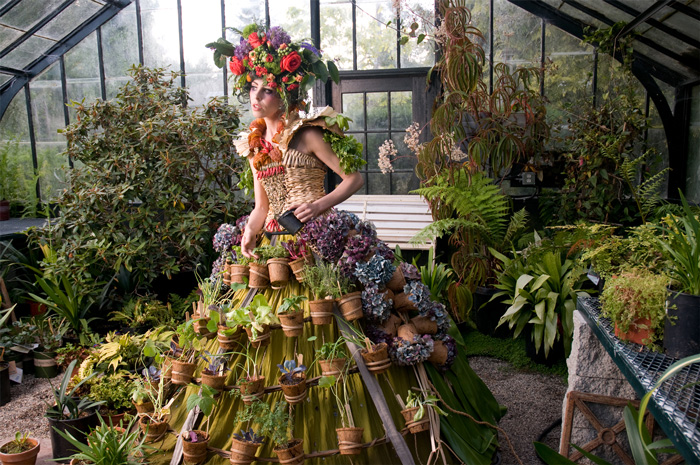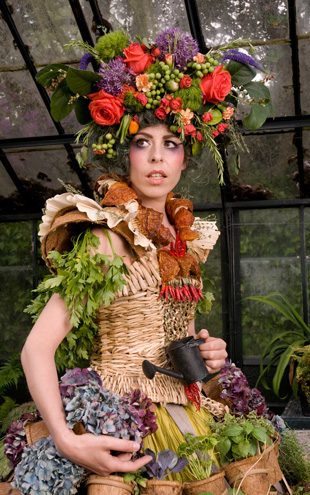Weedrobes: The Mobile Garden Dress
As an artist I work with natural materials because nature has much to teach us about the effect of cyclical growth and regeneration in our environment. All of the artwork I create is ephemeral; after a while it disintegrates and then it leaves no trace. The basic intent of my art is to challenge the prevalent colonial mindset that assumes that the natural world is either a resource for us to exploit or a recreational playground for our amusement. From this point, each new series I create deals with a wide range of issues, from consumerism to urban agriculture, by relating nature to our bodies, and our language. In my world, dresses are made of flowers, words are sculpted in ice, and shelters are fashioned from blackberry vines. The underlying principle being that if we can see ourselves as just one of the cogs in our planet's ecosystem, we may learn to treat it with more respect.
 For over 5 years I have been developing a series of wearable sculptures made from local plants, which I call Weedrobes. Each unique garment is created with what is in season at the time, and what is available either in my garden, in abandoned lots or local park compost piles. My work is as much about foraging as it is about creating, and it is often inspired by a leaf or a flower that I discover while walking or biking around Vancouver. In other instances, my work is informed by age-old techniques such as basketry and rope plaiting. The latest garment, The Mobile Garden Dress has a bustier made primarily from tule rush because I was looking for a soft and spongy material that would be comfortable to wear.
For over 5 years I have been developing a series of wearable sculptures made from local plants, which I call Weedrobes. Each unique garment is created with what is in season at the time, and what is available either in my garden, in abandoned lots or local park compost piles. My work is as much about foraging as it is about creating, and it is often inspired by a leaf or a flower that I discover while walking or biking around Vancouver. In other instances, my work is informed by age-old techniques such as basketry and rope plaiting. The latest garment, The Mobile Garden Dress has a bustier made primarily from tule rush because I was looking for a soft and spongy material that would be comfortable to wear.

The Mobile Garden Dress was conceived as a self-sustaining garden and portable shelter for the new urban nomad, complete with pots of edible plants and a hoop skirt that converts into a tent at night. This garment is 100% compostable and recyclable.
On her head Madame Jardin wears a coif of edible pants made from roses, carnations, alums, rosemary, thyme, lime leaves, pea, eggplants and chrysanthemums. The bustier is decorated with orange dried aji amarillo peppers, red hot chili peppers, corn husks, sprigs of thyme and fresh parsley. The hoop skirt is constructed from raw flax canvas, willow branches, seagrass rope, basketry reed and wood. The plants include vegetables such as lettuce, beans and brussels sprouts and the herbs range from sweet basil to rue and sage. Also included are edible nasturtiums for colour, and lavender for its fragrance and anti-septic qualities. All are planted in biodegradable coconut husk pots. The inner skirt is made from organic cotton that has been hand-dyed. The entire skirt is made movable with the use of casters (which will be re-used) at the bottom, which support the weight of the planted material.
The garment was commissioned by the Vancouver International Children’s Festival and it was worn everyday by actor/artist Nita Bowerman who interacted with people of all ages, engaging them in conversations about plants, gardens and composting. She had the children water her plants, rub them for smells and sometimes taste a bit of parsley.
At the end of the weeklong festival the dress was taken to the Southlands Nursery and photographed in the greenhouse, surrounded by potted plants. The dress was later set up in a Community Garden in False Creek, where we demonstrated the skirt’s transformation into a tent.
 Dog walkers and condo dwellers stopped by to chat as Madame Jardin nestled herself between the railroad tracks and vegetable patches. With her collapsed hoop skirt on her shoulder, wearing her chartreuse cotton gown and towing her plants behind her, she is ready for her next ecovention. The Mobile Garden Dress is the first Weedrobe not made entirely from decomposable materials, allowing it to be re-used in October for the World Food Day festivities at the Roundhouse Community Center in Vancouver.
Dog walkers and condo dwellers stopped by to chat as Madame Jardin nestled herself between the railroad tracks and vegetable patches. With her collapsed hoop skirt on her shoulder, wearing her chartreuse cotton gown and towing her plants behind her, she is ready for her next ecovention. The Mobile Garden Dress is the first Weedrobe not made entirely from decomposable materials, allowing it to be re-used in October for the World Food Day festivities at the Roundhouse Community Center in Vancouver.
Photo credits: Nicole Dextras

